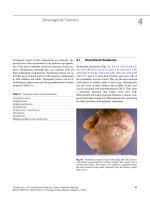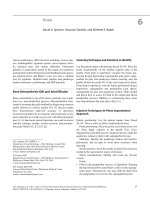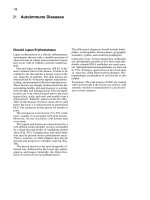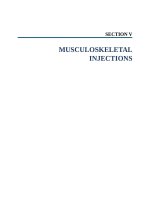Ebook Atlas of spleen pathology: Part 1
Bạn đang xem bản rút gọn của tài liệu. Xem và tải ngay bản đầy đủ của tài liệu tại đây (24.8 MB, 85 trang )
Atlas of Anatomic Pathology
Series Editor
Liang Cheng
Dennis P. O’Malley
Atlas of Spleen Pathology
Dennis P. O’Malley, M.D.
Clarient Inc./GE Healthcare
Aliso Viejo
California
USA
Adjunct Associate Professor
Department of Hematopathology
M.D. Anderson Cancer Center/
University of Texas
Houston
Texas
USA
ISBN 978-1-4614-4671-2
ISBN 978-1-4614-4672-9
DOI 10.1007/978-1-4614-4672-9
Springer New York Heidelberg Dordrecht London
(eBook)
Library of Congress Control Number: 2012948389
© Springer Science+Business Media New York 2013
This work is subject to copyright. All rights are reserved by the Publisher, whether the whole or part of the material is
concerned, specifically the rights of translation, reprinting, reuse of illustrations, recitation, broadcasting, reproduction
on microfilms or in any other physical way, and transmission or information storage and retrieval, electronic adaptation,
computer software, or by similar or dissimilar methodology now known or hereafter developed. Exempted from this
legal reservation are brief excerpts in connection with reviews or scholarly analysis or material supplied specifically
for the purpose of being entered and executed on a computer system, for exclusive use by the purchaser of the work.
Duplication of this publication or parts thereof is permitted only under the provisions of the Copyright Law of the
Publisher’s location, in its current version, and permission for use must always be obtained from Springer. Permissions
for use may be obtained through RightsLink at the Copyright Clearance Center. Violations are liable to prosecution
under the respective Copyright Law.
The use of general descriptive names, registered names, trademarks, service marks, etc. in this publication does not
imply, even in the absence of a specific statement, that such names are exempt from the relevant protective laws and
regulations and therefore free for general use.
While the advice and information in this book are believed to be true and accurate at the date of publication, neither
the authors nor the editors nor the publisher can accept any legal responsibility for any errors or omissions that may
be made. The publisher makes no warranty, express or implied, with respect to the material contained herein.
Printed on acid-free paper
Springer is part of Springer Science+Business Media (www.springer.com)
As with all of my works, I would like to dedicate this work to my wife, Karene. It is
through her love and support that I accomplish anything.
Preface
The spleen has always been mysterious in the history of medicine. It has had several characters
ascribed to it as a seat of emotions, or even as a site of pumping blood. However, in modern
medicine, the spleen, while well understood, still leads to diagnostic challenges. This is likely
due to its relative rarity as a diagnostic specimen, and the unusual combinations of pathology
that can occur. However, when considered in its component parts, splenic pathology can be
relatively straightforward and understood as an interesting mix of physiologic, anatomic, and
pathologic components. It is my hope that the images in this atlas, along with their descriptions, will help bring some understanding and appreciation to this “organ of mystery.”
vii
Acknowledgment
I would like to acknowledge Attilio Orazi, Richard Neiman, Thomas Dutcher, and Peter Banks,
who nurtured my interest in hematopathology, and in splenic pathology, specifically. My special thanks to the many pathologists who have shared gross images of splenic pathology; without their help this atlas would be far less illustrative. Finally, I would like to thank all of my
colleagues for their help, insights, and support during the production of this book.
ix
Contents
1
2
3
4
5
Normal Morphologic and Immunohistochemical Findings and Hyperplasias
1.1 Anatomy and Normal Histology ........................................................................
1.2 Hyperplasias .......................................................................................................
1.3 Normal Immunohistochemistry .........................................................................
2
6
7
Congenital Malformations and Abnormalities of Spleen Location
and Histology
2.1 Accessory Spleen ...............................................................................................
2.2 Intrapancreatic Spleen ........................................................................................
2.3 Polysplenia .........................................................................................................
2.4 Splenosis ............................................................................................................
2.5 Splenogonadal Fusion ........................................................................................
2.6 Other Findings....................................................................................................
12
13
13
14
14
15
Lymphoid Neoplasms
3.1 Splenic Marginal Zone Lymphoma ....................................................................
3.2 Chronic Lymphocytic Leukemia ........................................................................
3.3 Lymphoplasmacytic Lymphoma ........................................................................
3.4 Follicular Lymphoma .........................................................................................
3.5 Mantle Cell Lymphoma......................................................................................
3.6 Plasma Cell Myeloma ........................................................................................
3.7 Hairy Cell Leukemia ..........................................................................................
3.8 Hairy Cell Leukemia-Variant .............................................................................
3.9 Splenic Diffuse Red Pulp Small B-Cell Lymphoma ..........................................
3.10 Prolymphocytic Leukemia .................................................................................
3.11 Lymphoblastic Leukemia/Lymphoma ................................................................
3.12 Hepatosplenic T-cell Lymphoma .......................................................................
3.13 T-cell Large Granular Lymphocytic Leukemia ..................................................
3.14 Other T-cell Lymphomas ....................................................................................
3.15 Diffuse Large B-cell Lymphomas ......................................................................
3.16 Hodgkin Lymphoma...........................................................................................
18
23
26
27
30
32
33
37
38
39
40
40
43
46
49
55
Myeloid and Related Disorders
4.1 Extramedullary Hematopoiesis ..........................................................................
4.2 Myeloid Sarcoma/Acute Myeloid Leukemia .....................................................
4.3 Myeloproliferative Neoplasms ...........................................................................
4.4 Myelodysplastic Syndrome and Myelodysplastic/
Myeloproliferative Disorders ...............................................................................
4.5 Mastocytosis .......................................................................................................
4.6 Histiocytic Sarcoma ...........................................................................................
69
71
73
Nonhematopoietic Lesions Including Vascular
5.1 Cysts ...................................................................................................................
5.2 Hamartoma .........................................................................................................
5.3 Inflammatory Pseudotumor ................................................................................
76
78
83
60
61
64
xi
xii
Contents
5.4 Follicular Dendritic Cell Tumor ......................................................................... 84
5.5 Other Stromal Tumors ........................................................................................ 85
5.6 Splenic Artery Aneurysm................................................................................... 86
5.7 Benign Vascular Lesions .................................................................................... 87
5.8 Littoral Cell Angioma ........................................................................................ 92
5.9 Sclerosing Angiomatoid Nodular Transformation (SANT) ............................... 94
5.10 Vascular Tumors of Indeterminate and Malignant Behavior ............................. 96
5.11 Metastatic Tumors .............................................................................................. 99
Reference .................................................................................................................... 106
6
7
Reactive and Systemic Conditions
6.1 Rupture and Trauma ...........................................................................................
6.2 Infarction and Embolization ...............................................................................
6.3 Perisplenitis (Sugar-Coated Spleen)...................................................................
6.4 Congestive Splenomegaly ..................................................................................
6.5 Red Blood Cell Disorders ..................................................................................
6.6 Granulomas ........................................................................................................
6.7 Langerhans Cell Histiocytosis............................................................................
6.8 Storage Diseases.................................................................................................
6.9 Castleman Disease .............................................................................................
6.10 Therapy Effects ..................................................................................................
6.11 Other Disorders ..................................................................................................
6.12 Hemophagocytic Syndrome ...............................................................................
6.13 Autoimmune Disorders ......................................................................................
6.14 Immunodeficiency (Inherited and Acquired) .....................................................
Reference ....................................................................................................................
108
109
112
113
114
118
119
120
127
128
130
132
133
139
142
Infections
7.1 Bacterial .............................................................................................................
7.2 Mycobacteria ......................................................................................................
7.3 Viruses ................................................................................................................
7.4 Fungi ..................................................................................................................
7.5 Parasites and Protozoa........................................................................................
Reference ....................................................................................................................
144
145
147
151
155
156
Index . . . . . . . . . . . . . . . . . . . . . . . . . . . . . . . . . . . . . . . . . . . . . . . . . . . . . . . . . . . . . . . . . 157
1
Normal Morphologic and Immunohistochemical
Findings and Hyperplasias
Normal architecture is basic to an overall understanding of
splenic pathology. In this chapter, normal components of
spleen are illustrated. These include normal structures such
as red and white pulp, stromal elements, and vascular components. In addition, hyperplasias of splenic components are
illustrated. These are important, as the differential diagnosis
of many splenic lesions and lymphomas are benign proliferations of the same compartments. Follicular hyperplasia and
marginal zone hyperplasia are most commonly encountered
and also most closely mimicked by follicular lymphoma and
splenic marginal zone lymphoma, respectively. Other more
rare hyperplasias include proliferations of T cells and immunoblasts. Finally, the immunohistochemical architecture of
the spleen is richly illustrated. This is particularly important
in the evaluation of splenic lesions, as understanding of normal patterns of staining must precede the evaluation of stains
in pathologic processes. A combination of histologic, immunohistochemical, and gross images is presented.
D.P. O’Malley, Atlas of Spleen Pathology, Atlas of Anatomic Pathology,
DOI 10.1007/978-1-4614-4672-9_1, © Springer Science+Business Media New York 2013
1
2
1.1
1
Normal Morphologic and Immunohistochemical Findings and Hyperplasias
Anatomy and Normal Histology
Fig. 1.3 Normal spleen parenchyma. A higher magnification highlighting the features of an individual white pulp nodule. This is composed of a reactive germinal center with mantle zone and marginal
zone. Note that there is an adjacent splenic arteriole. White pulp nodules are analogous to “buds” whereas the arterioles are analogous to
“branches.” The red pulp in this image shows typical features with some
patent sinuses and more solid-appearing cords
Fig. 1.1 A radiograph of the lower thoracic and abdominal cavity. The
spleen is present in the middle left, beneath the ribs. The spleen is seen
as a round or bean-shaped organ. It lies adjacent to the stomach and
lateral to the pancreas
Fig. 1.2 Normal spleen parenchyma. An intermediate magnification of
normal spleen parenchyma. In this image, there are appropriate numbers of
germinal centers and white pulp admixed with red pulp. The white pulp
nodules are in their usual functional form, showing a tripartite arrangement,
with a germinal center (pale), a thin mantle zone (dark), and a pale outer
marginal zone. Some large caliber vessels (arterioles) are also present. Red
pulp shows some patent sinuses, with some circulating red blood cells
Fig. 1.4 Normal spleen red and white pulp. This low magnification
image of spleen shows a typical normal proportion of red pulp (RP) to
white pulp (WP). In general, the ratio of RP:WP is about 3–4:1, as in
this case
1.1
Anatomy and Normal Histology
Fig. 1.5 Red pulp. The splenic red pulp is composed of predominantly
splenic sinuses and splenic cords. Sinuses are lined by specialized
endothelial cells (eg, splenic littoral cells). The intervening spaces are
splenic cords. They contain stromal elements including splenic macrophages and some occasional lymphocytes
Fig. 1.6 Red pulp. Red pulp is a hypoxic environment. Red blood cells
enter into the splenic cords and then must traverse the walls of the
sinuses to return to the circulation. If red cells are not deformable, they
will be destroyed by splenic macrophages
Fig. 1.7 Spleen capsule. In this microscopic image, the spleen capsule
is present (lower). It is typically paucicellular with only rare, unremarkable spindle-shaped stromal cells present
3
Fig. 1.8 Spleen capsule. Another example of normal spleen capsule
(upper). The capsule is 50–100 microns thick. The presence of
significant cellular infiltrates can indicate pathology
Fig. 1.9 Fibrous trabeculae. Bands of fibrous tissue, contiguous with
the capsule, are present in the central portions of the spleen. There are
approximately the same thickness as the capsule and provide a framework for vascular and stromal elements in the spleen
Fig. 1.10 Splenic artery, elastin stain. Elastin stain of normal splenic
artery. Note the staining within the artery wall and the notable lack of
staining within the splenic red pulp. Elastic fibers are not a normal part
of the splenic red pulp architecture
4
1
Normal Morphologic and Immunohistochemical Findings and Hyperplasias
Fig. 1.11 Splenic sinus, Grocott’s methenamine silver (GMS) stain. In
this GMS stain, the “ring fibers” that wrap the endothelial sinus lining cells
are highlighted. These are akin to hoops around the staves of barrel
Fig. 1.12 Vessels, splenic hilum. This low magnification image shows
vessels in the splenic hilum. Hilar vessels include large caliber arteries and
veins, as well as lymphatics. The arteries merge together to form the
splenic artery. Only very limited lymphatics are present in the spleen.
They are seen only in the adventitial regions of the largest vessels penetrating the spleen. Normal splenic parenchyma does not have lymphatics
Fig. 1.13 Red pulp sinuses. In this example, the splenic sinuses are
patent. Cells within the sinus would likely be seen in the peripheral
blood circulation. Other more solid-appearing areas are cords
Fig. 1.14 Hyaline deposition, germinal center. In this example of a
germinal center, there is hyalinized protein (glassy, pink material) present in the central portion of the germinal center. In some circumstances,
this represents immunoglobulin protein deposition; however, in other
cases, its exact nature is not known. It is a benign finding and not
specific for any diagnosis
Fig. 1.15 White pulp nodule. This example shows the component of a
typical white pulp nodule. The usual follicles have a three-layer structure. The central portion is the germinal center (eg, secondary follicle).
The second layer is the mantle zone, composed of small, dark-blue,
slightly irregular lymphocytes. Finally, the third layer is the marginal
zone, composed of mostly small lymphocytes with increased amounts
of pale cytoplasm
1.1
Anatomy and Normal Histology
5
Fig. 1.16 White pulp nodule. As in the previous example, this white
pulp nodule is composed of three layers: germinal center, mantle zone,
and marginal zone. Note at the periphery is an arteriole in cross section,
which continues into the spleen and is surrounded by the periarteriolar
lymphoid sheath (PALS) region
Fig. 1.18 Periarteriolar lymphoid sheath. A longitudinal section of a
splenic arteriole with surrounding lymphoid sheath. These lymphoid
cells are predominantly T cells, although there are also occasional
admixed B cells
Fig. 1.17 White pulp nodule, primary follicle. In the unreacted spleen,
germinal centers have not been formed. In these cases, the white pulp
nodules have only two layers, the “mantle cell” core and the marginal
zone. These are “primordial” follicles or primary follicles, which have
not undergone a germinal center reaction
Fig. 1.19 Pediatric spleen. Although not instantly apparent, this is a
spleen from a 1-year-old patient. The subtle morphologic clue lies in
the perisplenic adipose tissue. There are lipoblasts present, which persist for a short time after birth (2–5 years)
6
1.2
1
Normal Morphologic and Immunohistochemical Findings and Hyperplasias
Hyperplasias
Fig. 1.20 Follicular hyperplasia. This gross image of an enlarged
spleen shows an increase in accentuation of white pulp components
corresponding to follicular hyperplasia. The accentuation of white pulp
nodules is the spleen is said to impart a miliary appearance, which
refers to the small white nodules appearing like millet seeds (small
grains). Compared to a normal spleen, these white pulp nodules are
increased in size and density. The findings are not specific, and could
look similar to a lymphoma with involvement of the white pulp. (Image
courtesy of D. Farhi, Atlanta, GA, USA)
Fig. 1.21 Follicular hyperplasia. In this low magnification image,
there is an increase in the proportion of white pulp compared to red
pulp, which is seen in follicular hyperplasia. The causes of follicular
hyperplasia are broad, and in general are related to immune activation
Fig. 1.22 Nodular lymphoid hyperplasia. Nodular (follicular) lymphoid hyperplasia is a rare finding in spleens. It may be grossly visible
as an enlarged white pulp nodule, mimicking focal involvement by a
lymphoid process or perhaps a granulomatous or inflammatory process.
Histologic examination reveals a coalescence of benign reactive germinal centers. These aggregate into nodules, thereby mimicking neoplastic processes. However, the morphologic and immunohistochemical
features of the individual follicles and cells are compatible with a reactive process
Fig. 1.23 Marginal zone hyperplasia. Hyperplasia of the splenic marginal zone has been arbitrarily defined as a thickening of the marginal
zone (third) layer of more than 10 cells. This case is at the borderline of
marginal zone hyperplasia, with possibly 10 or fewer cells in the third
layer. The remaining features are of a typical reactive follicle
1.3
Normal Immunohistochemistry
7
1.3
Fig. 1.24 Marginal zone hyperplasia. In this case, there is clear expansion of the outer (pale) layer of the follicular structure. There are more
than 10 cells in this layer, which constitutes marginal zone hyperplasia.
The cytologic composition is predominantly small and intermediate
sized lymphocytes, with round nuclei and increased amounts of pale
cytoplasm, imparting their marginal zone appearance. They are distinguished from the “mantle type” cells in the center that are smaller, have
dark blue nuclei, and almost no cytoplasm
Fig. 1.25 Primary follicle hyperplasia. In this example, there is a primary follicle present. Hyperplasia of primary follicle is a rare finding.
It is characterized by an overall increase in white pulp nodules composed of B cells without germinal center formation. The circumstances
of primary follicle hyperplasia are most often seen in early immunologic responses, in pediatric spleens and in association with suppression
of the normal immune response, such as with steroid therapy
Normal Immunohistochemistry
Fig. 1.26 CD3, normal spleen. The distribution of T cells in the normal spleen includes cells within the germinal center, some cells scattered in the mantle and marginal zones, many in the periarteriolar
lymphoid sheath, and scattered throughout the white pulp
Fig. 1.27 CD3, normal spleen, periarteriolar lymphoid sheath. This
CD3 stain highlights CD3-positive T-cells in the periarteriolar lymphoid sheath (PALS) region. In the splenic white pulp, this is a normal
distribution of T cells adjacent to arterioles
8
1
Normal Morphologic and Immunohistochemical Findings and Hyperplasias
Fig. 1.28 CD20 staining, normal spleen. CD20 stains mature B cells.
In this spleen, staining intensity of germinal center compared to the
mantle/marginal zone can be appreciated. In addition, there are some
scattered clusters and individual B cells within the red pulp
Fig. 1.30 CD4 staining, normal spleen. A CD4 immunohistochemical
in spleen highlights helper T cells (within white and red pulp) as well as
many macrophages and monocytic cells within the red pulp
Fig. 1.29 BCL2 staining, normal spleen. Immunohistochemical staining for bcl-2 protein in normal spleen. Note that in white pulp structures, the reactive germinal center is negative, but the normal mantle
zones and marginal zones are positive for bcl-2. Scattered T cells in the
red and white pulp are also positive
Fig. 1.31 CD8 staining, normal spleen. Aside from cytotoxic T cells,
CD8 immunohistochemical stains will highlight splenic littoral (eg,
sinus lining) cells. A CD8 stain is crucial in delineating the red pulp
architecture in the spleen and highlights red pulp pathology when
present
1.3
Normal Immunohistochemistry
9
Fig. 1.32 CD163 staining, normal spleen. CD163 highlights macrophages. In the spleen, the cordal regions are strongly positive, and
there is some staining in littoral (sinus) cells. There are also some scattered macrophages within white pulp, especially within activated germinal centers
Fig. 1.34 CD123 staining, normal spleen. CD123 is most commonly
positive in plasmacytoid dendritic cells. In this case, these are present at
the periphery of the marginal zone and PALS regions of white pulp.
Some rare B-cell lymphomas express CD123 but in my experience the
level of expression can only be detected by flow cytometry and is not
positive by immunohistochemistry
Fig. 1.33 CD42b staining, normal spleen. CD42b stains both megakaryocytes and platelets. Other than rare platelets within the sinuses, no
significant staining is seen in the normal spleen. However, rare individual megakaryocytes can be seen in some cases. If there are increases
(more than 1/10 HPF), extramedullary hematopoiesis or a neoplastic
myeloid proliferation should be considered
Fig. 1.35 KI-67 staining, normal spleen. Ki-67 is a marker of proliferation. In this image, normal germinal centers (secondary follicles) are
highly proliferative. Only rare proliferating cells are identified within
the red pulp
10
1
Normal Morphologic and Immunohistochemical Findings and Hyperplasias
Fig. 1.36 Factor VIII antigen, normal spleen. Factor VIII antigen will
stain platelets, megakaryocytes and endothelial elements. In normal
spleen, littoral cells (sinus-lining cells) are also positive
Fig. 1.38 CD21 Staining, normal spleen. CD21 staining in spleen is
seen in follicular dendritic cells (FDC) as well as some lymphocytes.
Strong reticular staining is seen in the FDC networks of the follicle, as
well as some weak and variable staining in lymphocytes of the marginal
zone
Fig. 1.37 CD31 staining, normal spleen. CD31 stains both endothelial
and histiocytic elements. In spleen, there is staining in cordal histiocytes, vascular endothelium, and some staining in littoral cells
Fig. 1.39 Smooth muscle actin staining, normal spleen. Smooth muscle actin stains myofibroblastic cells in the spleen, including cells that
line the margin between splenic marginal zone (white pulp) and red
pulp. In some animals, this margin is accentuated, and is a well-defined
structure, but it is subtle in humans
2
Congenital Malformations and Abnormalities
of Spleen Location and Histology
Congenital abnormalities of the spleen are rarely encountered. However, when present, they may be difficult to interpret due to unfamiliarity. Occasionally, they can mimic
serious pathology and should be familiar to pathologists to
exclude malignancies. Lesions illustrated in this chapter
include accessory spleen, which when present in unusual
locations may be a diagnostic problem; intrapancreatic
spleen, which is a rare occurrence and probably a variant of
accessory spleen; splenosis, which is marked by the presence
of multiple, small, fragments of functional splenic tissue
within the abdominal cavity; and splenogonadal fusion, a
rare lesion that may involve unusual clinical presentations,
including left-sided inguinal hernia. Finally, surface grooves
present in the spleen are illustrated and their embryologic
origin is identified. Both histologic and gross images are
presented.
D.P. O’Malley, Atlas of Spleen Pathology, Atlas of Anatomic Pathology,
DOI 10.1007/978-1-4614-4672-9_2, © Springer Science+Business Media New York 2013
11
12
2.1
2
Congenital Malformations and Abnormalities of Spleen Location and Histology
Accessory Spleen
Fig. 2.1 Accessory spleen. A section of spleen with attached pancreas
and omentum. In the mass of tissue arising from the hilum, there is a
small nodule (approximately 2 cm) of dark red purple tissue. This is an
accessory spleen. They are seen in approximately 10 % of the population and are most commonly seen in the splenic hilar region. (Image
courtesy of D. Farhi, Atlanta, GA, USA.)
a
b
Fig. 2.2 Accessory spleen. This pathologic specimen was submitted
as an “enlarged lymph node” with a suspicion of metastatic carcinoma.
It was seen adjacent to the pancreas and, as illustrated by histology (a)
and immunohistochemical stains for CD8 (b), is an accessory spleen.
CD8 staining highlights the distinctive splenic sinus architecture of the
spleen and can be useful in identifying spleen tissue at unusual sites
Fig. 2.3 Gross image of a sectioned accessory spleen. In this case, the
accessory spleen was approximately 5 cm in diameter. Note that the cut
surface has is a deep red color, similar to the spleen. (Image courtesy of
L. Morgenstern, Los Angeles, CA, USA.)









